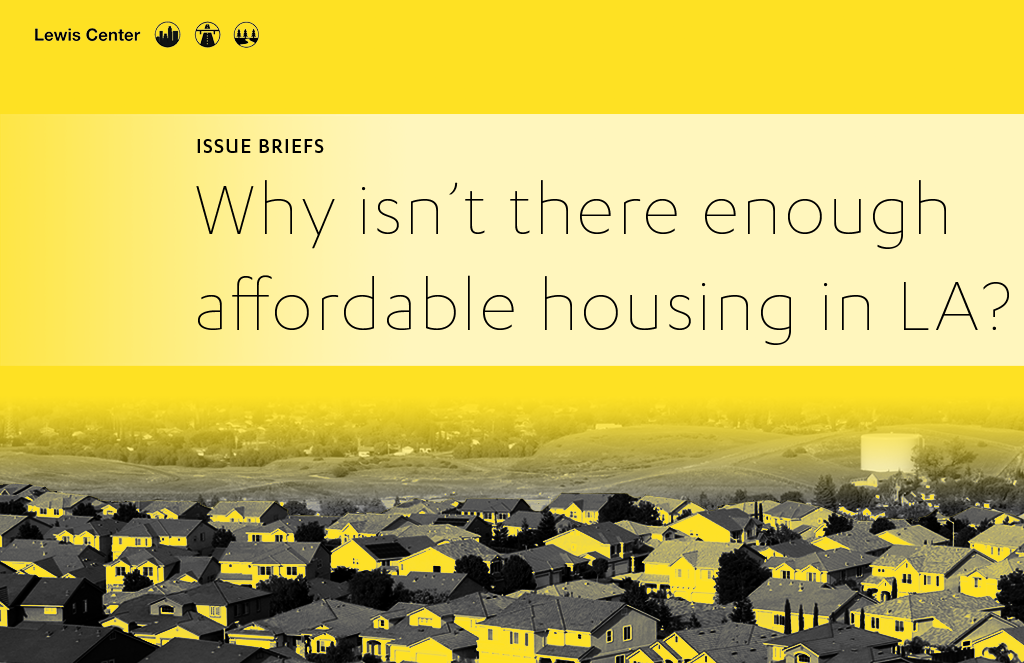The research is clear: Los Angeles needs to build more housing.
The city’s affordability crisis, which drives its growing homelessness, displacement, and resident cost burdens, is indisputably the result of a severe housing shortage. The pace of housing development has not remotely kept pace with the increase in new residents over the past three decades.
Why isn’t there enough affordable housing in LA? And what could be done to create more?
Lewis Center faculty and students have spent the past year studying these question in detail, and have produced three briefs detailing new research into the causes of, and potential solutions to, LA’s housing problems:
- Is Los Angeles Destroying Its Affordable Housing Stock to Build Luxury Apartments?
- How Proposition U Restrains Los Angeles Housing Development
- Overcoming Opposition to New Housing
Together, the research briefs draw straightforward conclusions about what’s behind the Los Angeles housing crisis — and how the tide might be turned:
The lack of housing helps the rich and hurts everyone (and everything) else
Systemic factors that block new housing development exacerbate existing spatial inequalities by pricing low- and middle-income households out of neighborhoods with quality public services, particularly high-performing schools. California’s tight land use regulations often benefit homeowner property values while harming commercial values, and low-density zoning also hurts the regional economy. Cities where workers struggle to find housing become less appealing to firms that rely on a local labor pool.
Clear barriers stand in the way of new housing
Current residents are structurally incentivized to oppose newcomers, and drive the frequent opposition to new development by raising concerns about the built environment, about who their neighbors might be, and about the development process. By way of three overarching systems — planning, legal, and political — residents have approximately 20 formal avenues to oppose housing. Moreover, when LA County voters passed Proposition U to curtail large multifamily housing development in 1986, they permanently and dramatically decreased the potential of the city’s commercial corridors. Because LA is now short on vacant parcels zoned for multifamily, many fear that old (affordable) units will inevitably be demolished to make way for new (expensive) housing.
New housing can create stronger neighborhoods
The Los Angeles region would benefit from more housing in a multitude of ways. New, densely-built infill housing is more environmentally friendly than homes built on the urban periphery, as it allows residents to live closer to transit and employment. And the construction of new housing — even luxury housing — in LA almost never results in a loss of low-cost units; new multifamily units typically replace single family homes or are built on land not previously used for housing. Denser corridors would be the foundation for mixed-use neighborhoods where residents could get around without having to drive everywhere. And the creation of new space for housing that does not cause the loss of affordable units or harm the equity of surrounding homeowners.
New housing lifts everyone up
Expanding housing supply, even at rents above the average, is important. Blocking development does not prevent neighborhood change; where rents are on the rise because there is too much demand and not enough supply, residents are often displaced and excluded just as effectively as where new luxury towers are built. Increasing the availability of rentals for higher-income renters at a minimum will make them less likely to outbid households with lower incomes for the older rental units. Even expensive new units improve overall affordability, as high-income households move into the newer, more expensive units and free up existing units, which are then accessible to households with lower incomes.
But it must be built everywhere in order to prevent displacement
There is a clear geographic pattern to current multifamily housing construction, and very little is being built in the wealthier neighborhoods in the Westside of Los Angeles. To even the playing field around development decisions, cities can build non-traditional platforms, such as social media and web forums, and disband existing input channels to cut down on the current overrepresentation of older, whiter, wealthier residents in neighborhood councils. Repealing Proposition U would direct development to underutilized corridors with low housing inventories and alleviate pressures on existing residential areas who wish to preserve community character. A holistic policy requires prioritizing housing subsidies and mechanisms to keep people in their homes in addition to increased housing supply.
These briefs and others can be found on the issue briefs page of the Lewis Center website.
